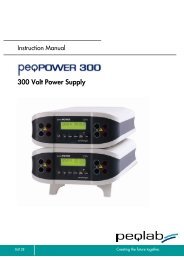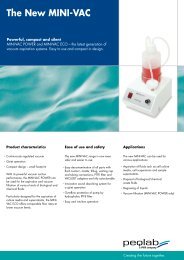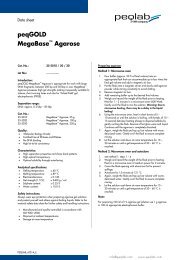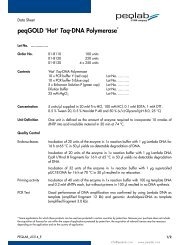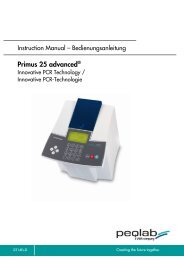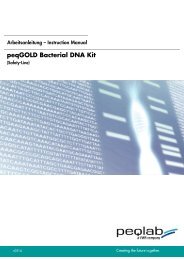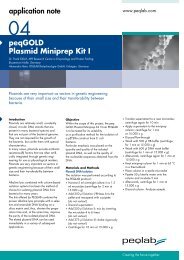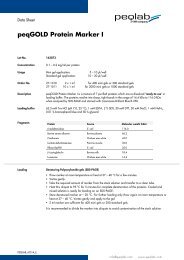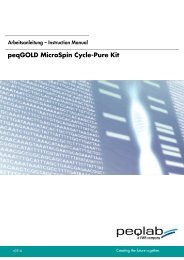peqGOLD Blood RNA Kit - Peqlab
peqGOLD Blood RNA Kit - Peqlab
peqGOLD Blood RNA Kit - Peqlab
- Keine Tags gefunden...
Erfolgreiche ePaper selbst erstellen
Machen Sie aus Ihren PDF Publikationen ein blätterbares Flipbook mit unserer einzigartigen Google optimierten e-Paper Software.
INHALTEINLEITUNG 1FUNKTIONSPRINZIP 2KITBESTANDTEILE 3LAGERUNG 3BINDEKAPAZITÄT 3WICHTIGE HINWEISE 4PEQGOLD BLOOD <strong>RNA</strong> ISOLIERUNGSPROTOKOLLE 5DNA-KONTAMINATIONEN 8QUANTIFIZIERUNG UND LAGERUNG DER <strong>RNA</strong> 8<strong>RNA</strong>-QUALITÄT 9BESTELLINFORMATIONEN 9TROUBLESHOOTING TIPS 10CONTENTINTRODUCTION 11PRINCIPLE 11KIT COMPONENTS 12STORAGE AND STABILITY 12BINDING CAPACITY 12BEFORE STARTING 13PEQGOLD BLOOD <strong>RNA</strong> ISOLATION PROTOCOL 14DNA CONTAMINATION 17QUANTIFICATION AND STORAGE OF <strong>RNA</strong> 17<strong>RNA</strong> QUALITY 17ORDERING INFORMATION 18TROUBLESHOOTING TIPS 19APPENDIX 20<strong>peqGOLD</strong> <strong>Blood</strong> <strong>RNA</strong> <strong>Kit</strong> Art.-Nr.: 12-6814/12-6614PEQLAB_v0314 1
EINLEITUNGDer <strong>peqGOLD</strong> <strong>Blood</strong> <strong>RNA</strong> <strong>Kit</strong> bietet eine schnelle und einfache Methode, um Gesamtzell-<strong>RNA</strong> aus bis zu 1.5 ml frischem oder mit Antikoagulantien wie Heparin, EDTA oder Citrat-Dextrose behandeltem Blut zu isolieren. In weniger als 60 Minuten können aus 1 mlfrischem Vollblut 1 bis 5 µg <strong>RNA</strong> isoliert werden. Kontaminationen und Enzyminhibitorenwerden dabei vollständig entfernt, wodurch die <strong>RNA</strong>-Isolierung schnell, einfach angenehmund verlässlich durchgeführt werden kann. Extraktionen mit organischen Lösungsmitteln,wie Phenol oder Chloroform, müssen ebenso wenig durchgeführt werden, wie Fällungenmit Isopropanol oder LiCl sowie zeitaufwendige CsCl-Dichtegradientenzentrifugationen.<strong>RNA</strong>, die mit dem <strong>peqGOLD</strong> <strong>Blood</strong> <strong>RNA</strong> <strong>Kit</strong> isoliert wurde, kann für alle Arten vonFolgeexperimenten, wie RT-PCRs, Poly(A) + -<strong>RNA</strong>-Extraktionen, Northern Blots, NucleaseProtection Assays und in vitro-Translationen weiterverwendet werden.<strong>peqGOLD</strong> <strong>Blood</strong> <strong>RNA</strong> <strong>Kit</strong>s werden wahlweise mit Safety-Line oder mit Classic-Line Säulengeliefert (Safety-Line, Best.-Nr. 12-6814-xx oder Classic-Line, Best.-Nr. 12-6614-xx).Schnappdeckel sorgen bei den Safety-Line Säulen für einen sicheren Verschluss und füreinen zusätzlichen Schutz vor Kreuzkontaminationen. Classic-Line Säulen haben keinenDeckel und erleichtern so das Handling.FUNKTIONSPRINZIPDie <strong>peqGOLD</strong> <strong>Blood</strong> <strong>RNA</strong> <strong>Kit</strong>s kombinieren die selektiven und reversiblenBindungseigenschaften von PerfectBind Silikamembranen mit der Schnelligkeit und leichtenDurchführbarkeit von Zentrifugationssäulenmethoden. Die im Blut enthaltenen Erythrozytenwerden selektiv lysiert und danach die Leukozyten durch Zentrifugation gesammelt. Nachder Lyse der weißen Blutzellen wird die Gesamtzell-<strong>RNA</strong> an die Silikamembran gebunden,an der sie problemlos gewaschen werden kann. Ein speziell entwickeltes und optimiertesPuffersystem erlaubt die Reinigung von nicht-degradierter <strong>RNA</strong> ab Moleküllängen von 200Basen. Zellulärer Debris, Hämoglobin und andere Kontaminationen werden effiziententfernt und die qualitativ sehr hochwertige <strong>RNA</strong> eluiert.Die <strong>peqGOLD</strong> <strong>Blood</strong> <strong>RNA</strong> <strong>Kit</strong>s wurden speziell für die Extraktion von Gesamtzell-<strong>RNA</strong>aus bis zu 1.5 ml Vollblut entwickelt. Das System wird nicht durch die Bindekapazität derverwendeten PerfectBind <strong>RNA</strong> Columns (bis ca. 100 µg <strong>RNA</strong>/PerfectBind <strong>RNA</strong> Column),wohl aber durch das maximal einsetzbare Probenvolumen limitiert. Aufgrund der großenMenge der im Blut enthaltenen Erythrozyten und Proteine werden Ertrag und Qualität dererhaltenen <strong>RNA</strong> bei Verwendung größerer Probenvolumina deutlich reduziert.Das <strong>peqGOLD</strong> <strong>Blood</strong> <strong>RNA</strong> <strong>Kit</strong> kann auch für die <strong>RNA</strong>-Extraktion aus gefrorenen Blutprobeneingesetzt werden jedoch ist das Probenvolumen dann auf 150 µl pro PerfectBind <strong>RNA</strong>Column begrenzt.<strong>peqGOLD</strong> <strong>Blood</strong> <strong>RNA</strong> <strong>Kit</strong> Art.-Nr.: 12-6814/12-6614PEQLAB_v0314 2
KITBESTANDTEILE<strong>peqGOLD</strong> <strong>Blood</strong> <strong>RNA</strong> <strong>Kit</strong>s 5 Reinigungen 50 Reinigungen 200 ReinigungenBestellnummer Safety Line 12-6814-00 12-6814-01 12-6814-02Bestellnummer Classic Line 12-6614-00 12-6614-01 12-6614-02BestandteilePerfectBind <strong>RNA</strong> Columns 5 50 200DNA Removing Columns 5 50 2002.0 ml Collection Tubes 20 200 4 x 200Lysis Buffer ER 3 ml 30 ml 90 ml<strong>RNA</strong> Lysis Buffer T 2 x1.5 ml 32 ml 125 ml<strong>RNA</strong> Wash Buffer I 5 ml 50 ml 200 ml<strong>RNA</strong> Wash Buffer II 2 ml 20 ml 3 x 20 mlRNase freies Wasser 1 ml 5 ml 20 mlArbeitsanleitung 1 1 1LAGERUNGDie Aufbewahrung des <strong>peqGOLD</strong> <strong>Blood</strong> <strong>RNA</strong> <strong>Kit</strong>s sollte bei Raumtemperatur erfolgen. Beieiner Umgebungstemperatur von 22 – 25 °C bleiben die Komponenten des <strong>Kit</strong>s fürmindestens 12 Monate ab Lieferung stabil. Kristalle, die sich während der Lieferung oderLagerung im <strong>RNA</strong> Lysis Buffer T bilden, können durch Erwärmen auf 37 °C wieder gelöstwerden.Es gilt zu beachten, dass der Lysis Buffer ER vor Verwendung auf 4 °C gekühlt werden mussund daher bei dieser Temperatur aufbewahrt werden kann.BINDEKAPAZITÄTPerfectBind <strong>RNA</strong> Columns haben eine <strong>RNA</strong>-Bindekapazität von ca. 100 µg <strong>RNA</strong> pro Säule.Die Verwendung von mehr als 1.5 ml Blut (mehr als 1 x 10 7 kernhaltige Zellen) wird nichtempfohlen.<strong>peqGOLD</strong> <strong>Blood</strong> <strong>RNA</strong> <strong>Kit</strong> Art.-Nr.: 12-6814/12-6614PEQLAB_v0314 3
WICHTIGE HINWEISEBitte lesen Sie das vorliegende Protokoll vor der ersten Verwendung des <strong>Kit</strong>s vollständigdurch und legen Sie vor Präparationsbeginn alle für die Isolierung benötigten Materialienbereit, um durch unnötige Zeitverzögerungen verursachte <strong>RNA</strong>-Degradationen zuvermeiden.! Bei allen Arbeiten mit <strong>RNA</strong> sollten zur Vermeidung von RNase-KontaminationenEinmalhandschuhe getragen werden. Zum Pipettieren der im <strong>Kit</strong> enthaltenen Puffersollten ausschließlich saubere, RNase-freie Einmalpipettenspitzen verwendet werden.! <strong>RNA</strong>-Präparationen sollten besonders sorgfältig, aber auch so zügig wie möglichdurchgeführt werden.! Bei niedrigen Außentemperaturen kann es im <strong>RNA</strong> Lysis Buffer T zur Bildung vonSalzkristallen kommen. Diese Kristallbildung ist normal, sollte aber vor der Verwendungdes Puffers durch Erwärmen auf 37 °C rückgängig gemacht werden.! Die verwendeten Blutproben sollten mit einem Antikoagulans, vorzugsweise mit Citrat-Dextrose, versetzt und möglichst schnell aufgearbeitet werden, da die in den Leukozytenenthaltenen Transkripte unterschiedlich lange und zum Teil nur sehr kurzeHalbwertszeiten aufweisen.! Das Einfrieren der Blutproben sollte möglichst vermieden werden, da es eine vorzeitigeLyse der Erythrozyten bewirkt. Die effiziente Entfernung ihrer Abfallprodukte ist dannnicht mehr möglich, weshalb auch nicht mehr als 150 µl gefrorenes Blut proAufarbeitung verwendet werden können. Der <strong>RNA</strong>-Ertrag wird dadurch zwangsläufigreduziert.! Lysis Buffer ER wird als Konzentrat geliefert und muss vor seiner ersten Verwendung ineinem geeigneten Gefäß mit sterilem, deionisierten RNase-freiem Wasser verdünntwerden:<strong>Kit</strong> 12-6814-00<strong>Kit</strong> 12-6814-01<strong>Kit</strong> 12-6814-023 ml Lysis Buffer ER mit 97 ml dH 2 O mischen.30 ml Lysis Buffer ER mit 970 ml dH 2 O mischen.90 ml Lysis Buffer ER mit 2910 ml dH 2 O mischen.! <strong>RNA</strong> Wash Buffer II wird als Konzentrat geliefert und muss vor seiner erstenVerwendung mit absolutem Ethanol verdünnt werden:<strong>Kit</strong> 12-6814-00<strong>Kit</strong> 12-6814-01<strong>Kit</strong> 12-6814-022 ml Wash Buffer II mit 8 ml EtOH abs. mischen.20 ml Wash Buffer II mit 80 ml EtOH abs. mischen.3 x 20 ml Wash Buffer II mit 3 x 80 ml EtOH abs. mischen.! Verdünnten <strong>RNA</strong> Wash Buffer II bei Raumtemperatur lagern.! Wenn nicht anders angegeben, müssen alle Zentrifugationsschritte bei 22 – 25 °Causgeführt werden.<strong>peqGOLD</strong> <strong>Blood</strong> <strong>RNA</strong> <strong>Kit</strong> Art.-Nr.: 12-6814/12-6614PEQLAB_v0314 4
PEQGOLD BLOOD <strong>RNA</strong> ISOLIERUNGSPROTOKOLLEBenötigte Materialien, die nicht mitgeliefert werden:! 100 % Ethanol und steriles dH 2 O! 70 % Ethanol (mit sterilem RNase-freiem Wasser verdünnt)! Sterile, RNase-freie Pipettenspitzen und ZentrifugenröhrchenHinweis: Nach Lyse und Entfernen der Erythrozyten müssen die folgenden Schritte beiRaumtemperatur ausgeführt werden. Arbeiten Sie schnell, aber sorgfältig.1. Lyse der Erythrozyten10 ml kalten Lysis Buffer ER (4 °C, falls nötig eine ready-to-use Lösung herstellen!) zu 0.5 mlbis 1.5 ml Blutprobe geben. 15 ml Falcon Tube verwenden.Probe für 15 Minuten auf Eis inkubieren und dabei zweimal durch kurzes Vortexenmischen. Während der Lyse der Erythrozyten wird die Mischung durchscheinend. BeiBlutproben von Personen mit einem erhöhten Hämatokritwert oder ECR, sollte dieInkubationszeit auf 20 Minuten verlängert werden.Leukozyten durch Zentrifugieren für 15 Minuten bei 2.500 x g* und 4 °C pelletieren. DenÜberstand mit den lysierten Erythrozyten komplett entfernen und verwerfen.Falls eine kühlbare Zentrifuge nicht verfügbar ist, bei Raumtemperatur zentrifugieren, aber denSchritt schnell abschließen.Pellet nicht verwerfen und Lysis Buffer ER durch Invertieren des Tubes auf ein Papiertuchvollständig entfernen.2. Waschen der LeukozytenLeukozytenpellet mit 5 ml kaltem Lysis Buffer ER (4 °C) durch Mischen resuspendieren,anschließend für 3 Minuten bei 2.500 x g* und 4 °C zentrifugieren. Den Überstand mit denlysierten Erythrozyten vollständig entfernen und verwerfen.Reste des Lysis Buffer ER durch Invertieren des Tubes auf ein Papiertuch entfernen.* Umrechnung g (rcf) / rpm siehe Appendix, S. 20<strong>peqGOLD</strong> <strong>Blood</strong> <strong>RNA</strong> <strong>Kit</strong> Art.-Nr.: 12-6814/12-6614PEQLAB_v0314 5
3. Lyse der LeukozytenLeukozytenpellet mit 600 µl Lysis Buffer T versetzen und durch Pipettieren vollständigresuspendieren, danach bei Raumtemperatur für 2 Minuten inkubieren.Pellet muss vollständig resuspendiert werden. Falls Klumpen zurückbleiben, weitere 5 Minuten beiRaumtemperatur inkubieren.Die Probe kann nach Zugabe von <strong>RNA</strong> Lysis Puffer T bei –70 °C gelagert werden.Eine DNA Removing Column in ein 2.0 ml Collection Tube stecken und das Lysat auf dieDNA Removing Column laden und anschließend für 2 Minuten bei 10.000 x g*zentrifugieren.Das filtrierte Lysat benötigen Sie für den nächsten Schritt, die DNA Removing Column bitteverwerfen.Bei der Verwendung von mehr als 1 x 10 7 Zellen kann das Lysat zu viskos sein, um es zupipettieren. In diesem Fall den Ansatz in zwei Aliquots teilen und jedes der Aliquots mit 650 µl <strong>RNA</strong>Lysis Buffer T auffüllen. Das Protokoll wird dann mit Schritt 3 mit zwei DNA Removing Columns undzwei PerfectBind <strong>RNA</strong> Columns fortgeführt.4. Laden und BindenGleiches Volumen 70 % Ethanol (~ 600 µl) zum Lysat geben und durch Pipettieren mischen.Nach der Zugabe von Ethanol kann sich ein Präzipitat bilden, das jedoch keineAuswirkungen auf die <strong>RNA</strong>-Isolation hat.Eine PerfectBind <strong>RNA</strong> Column in ein neues 2.0 ml Collection Tube stecken und denvollständigen Ansatz (inklusive Präzipitat) auf die PerfectBind <strong>RNA</strong> Column laden und für1 Minute bei 10.000 x g* zentrifugieren. Die maximale Kapazität der Säule ist 700 µl.Säulendurchfluss verwerfen und den Vorgang wiederholen, bis die gesamte Probe auf dieSäule geladen ist.5. Waschen INeues Collection Tube nutzen, 500 µl <strong>RNA</strong> Wash Buffer I auf die PerfectBind <strong>RNA</strong> Columnzugeben und für 1 Minute bei 10.000 x g* durch die Säule zentrifugieren.Säulendurchfluss verwerfen und Collection Tube weiterverwenden.6. DNase I Verdau (optional)Da durch die PerfectBind <strong>RNA</strong>-Technologie die vorhandene DNA größtenteils entferntwird, ist ein zusätzlicher DNase-Verdau für die meisten Folgeanwendungen nichterforderlich. Dennoch kann eine DNA-Entfernung bei einigen sensitiven <strong>RNA</strong>-Anwendungen nötig sein. Außerdem kann es bei der <strong>RNA</strong>-Isolation aus > 1 ml Blutprobeerforderlich sein, restliche DNA durch DNase-Behandlung zu entfernen. Das folgendeProtokoll beschreibt den DNase I-Verdau direkt auf der PerfectBind <strong>RNA</strong> Column(Bestellnr.: 12-1091).* Umrechnung g (rcf) / rpm siehe Appendix, S. 20<strong>peqGOLD</strong> <strong>Blood</strong> <strong>RNA</strong> <strong>Kit</strong> Art.-Nr.: 12-6814/12-6614PEQLAB_v0314 6
a. Für jede PerfectBind <strong>RNA</strong> Column folgenden DNase I Reaktionsmix vorbereiten:DNase I Digestion Puffer 73.5 µlRNase-freie DNase I (20 Kunitz units/µl) 1.5 µlGesamtvolumen 75 µlHinweise:1. DNase I ist sehr empfindlich gegenüber physikalischer Denaturierung, deshalb DNase I-Lösung niemals vortexen! Ein Invertieren des Tubes reicht zum Mischen aus. Den DNase IReaktionsmix immer direkt vor der <strong>RNA</strong>-Isolation ansetzen.2. Der DNase I Digestion Buffer ist im RNase-freien DNase I Digest <strong>Kit</strong> enthalten. StandardDNase Puffer sind nicht für den "on-membrane" Verdau geeignet!b. 75 µl des DNase I Reakionsmixes mittig auf die Membran der PerfectBind <strong>RNA</strong>Column pipettieren. Der DNase I Verdau kann nicht vollständig ablaufen, wenn einTeil des Reaktionsmixes an der Wand oder dem O-Ring der PerfectBind <strong>RNA</strong> Columnhaftet.c. PerfectBind <strong>RNA</strong> Column bei Raumtemperatur (25 - 30 °C) für 15 Minuteninkubieren.d. Säule in ein neues 2 ml Collection Tube stecken und 400 µl <strong>RNA</strong> Wash Buffer Izugeben. Säule bei Raumtemperatur für 5 Minuten inkubieren. Anschließend bei10.000 x g* für 5 Minuten zentrifugieren und Durchfluss verwerfen. Collection Tubeim nächsten Schritt (Schritt 4) weiterverwenden.7. Waschen IIPerfectBind <strong>RNA</strong> Column mit 650 µl des komplettierten <strong>RNA</strong> Wash Buffer II auf die Säulepipettieren. Bei 10.000 x g* für 1 Minute zentrifugieren, Durchfluss verwerfen.<strong>RNA</strong> Wash Puffer II Konzentrat muss vor Gebrauch mit absolutem Ethanol verdünnt werden.Hinweis auf dem Flaschenetikett.8. Trocknen (Essentieller Schritt! Zeit nicht verkürzen!)Die Säule erneut mit 650 µl <strong>RNA</strong> Wash Buffer II waschen. Hierfür bei 10.000 x g* für1 Minute zentrifugieren und Durchfluss anschließend verwerfen. Collection Tubewiederverwenden und Säule durch zweiminütiges Zentrifugieren bei 10.000 x g* vollständigtrocknen.9. ElutionPerfectBind <strong>RNA</strong> Column in ein sauberes 1.5 ml Zentrifugenröhrchen überführen und die<strong>RNA</strong> mit 30 bis 50 µl RNase-freiem Wasser eluieren. Dazu mittig auf die Matrixpipettieren, Säule für eine Minute bei Raumtemperatur inkubieren und anschließend für1 Minute bei 6.000 x g* zentrifugieren. Eine zweite Elutionsrunde kann zur Erhöhung desErtrags nötig sein.* Umrechnung g (rcf) / rpm siehe Appendix, S. 20<strong>peqGOLD</strong> <strong>Blood</strong> <strong>RNA</strong> <strong>Kit</strong> Art.-Nr.: 12-6814/12-6614PEQLAB_v0314 7
Hinweis: Keine <strong>RNA</strong>-Extraktionsmethode kann genomische DNA vollständig entfernen. Für sehrsensitive Anwendungen sollte die eluierte <strong>RNA</strong> mit RNase-freier DNase behandelt werden. Auch fürRT-PCR sollten Intron-umspannende Primer verwendet werden, die eine einfache Identifikation vonDNA-Kontamination erlauben. Eine Kontroll-PCR-Reaktion mit der <strong>RNA</strong> als Template erlaubtebenfalls die Detektion von DNA-Kontaminationen.DNA-KONTAMINATIONENMit keinem der aktuell verfügbaren <strong>RNA</strong>-Extraktionssysteme ist es möglich, genomischeDNA vollständig zu entfernen. Für sensitive Experimente wie Differential Display oder RT-PCRs muss deshalb ein DNase I Verdau durchgeführt werden. Eine einfache undzeitsparende Möglichkeit bietet der DNase-Verdau direkt auf der PerfectBind <strong>RNA</strong> Column,der in das bestehende Protokoll integriert werden kann (s. Punkt 5: DNase I Verdau).Alternativ kann auch eine Nachbehandlung der isolierten <strong>RNA</strong> mit RNase-freier DNasedurchgeführt werden.Der Nachweis des Vorhandenseins oder Fehlens von DNA-Kontaminationen kann mit Hilfe vonintronüberspannenden Primern erfolgen, wobei das Entstehen von Banden Rückschlüsse aufmögliche Kontaminationen zulässt.QUANTIFIZIERUNG UND LAGERUNG DER <strong>RNA</strong>Um die Konzentration und Reinheit einer <strong>RNA</strong>-Lösung zu bestimmen, muss die Absorptioneines geeignet verdünnten Aliquots (10- bis 50-fach) bei 260 nm und 280 nm gemessenwerden.RNase-freies dH 2 O ist leicht sauer und kann die gemessenen Absorptionswerte dramatischherabsetzen. Für die spektrophotometrische Analyse sollte die <strong>RNA</strong> deshalb besser in einer gepuffertenLösung wie beispielsweise TE verdünnt werden.Eine A 260 -Einheit entspricht dabei 40 µg <strong>RNA</strong>/ml. Die Konzentration berechnet sichdemnach wie folgt:<strong>RNA</strong>-Konzentration (µg/ml) = Absorption 260 x 40 x VerdünnungsfaktorDas A 260/280 -Verhältnis reiner Nukleinsäuren liegt bei 2.0. Das mit dem <strong>peqGOLD</strong> <strong>Blood</strong><strong>RNA</strong> <strong>Kit</strong> erzielbare A 260/280 -Verhältnis von 1.8 bis 2.0 entspricht <strong>RNA</strong> einer Reinheit von90 bis 100 %.Phenol hat ein Absorptionsmaximum bei 275 nm und kann deshalb mit den Absorptionsspektrenvon <strong>RNA</strong> und DNA interferieren. Da das Protokoll des <strong>peqGOLD</strong> <strong>Blood</strong> <strong>RNA</strong> <strong>Kit</strong>s kein Phenolverwendet, tritt dieses Problem hier nicht auf.<strong>RNA</strong>, die mit dem <strong>peqGOLD</strong> <strong>Blood</strong> <strong>RNA</strong> <strong>Kit</strong> aufgereinigt wurde, kann in sterilem RNasefreiemWasser für mindestens ein Jahr bei –70 °C aufbewahrt werden.<strong>peqGOLD</strong> <strong>Blood</strong> <strong>RNA</strong> <strong>Kit</strong> Art.-Nr.: 12-6814/12-6614PEQLAB_v0314 8
<strong>RNA</strong>-QUALITÄTVor ihrer Verwendung in Folgeexperimenten sollte durch denaturierendeAgarosegelelektrophorese und Ethidiumbromidfärbung zunächst die Qualität derextrahierten <strong>RNA</strong> bestimmt werden. Auf dem gefärbten Gel müssen zwei scharfe Bandenerkennbar sein, die die ribosomalen 28 S und 18 S r<strong>RNA</strong>s repräsentieren. Sollten dieseBanden in Richtung nieder-molekularer <strong>RNA</strong>-Größen schmieren, ist es während derPräparation, Lagerung oder Weiterbearbeitung zu einer Degradation gekommen, die sichje nach Folgeexperiment mehr oder weniger negativ auswirken kann.Obwohl <strong>RNA</strong>-Moleküle < 200 Basen nur sehr ineffizient an die PerfectBind <strong>RNA</strong> Column des<strong>peqGOLD</strong> <strong>Blood</strong> <strong>RNA</strong> <strong>Kit</strong>s binden, kann auf dem Gel noch eine dritte distinkte Bande aus t<strong>RNA</strong>serscheinen. Diese Bande tritt vor allem dann auf, wenn die Zellzahl im Ausgangsmaterialbesonders hoch war.BESTELLINFORMATIONENfür die <strong>RNA</strong>-Isolierung aus Zellen, Geweben und Blut:<strong>peqGOLD</strong> Total <strong>RNA</strong> <strong>Kit</strong> 12-6634-00 5 Reinigungen(C-Line) 12-6634-01 50 Reinigungen12-6634-02 200 Reinigungen<strong>peqGOLD</strong> Total <strong>RNA</strong> <strong>Kit</strong> 12-6834-00 5 Reinigungen(S-Line) 12-6834-01 50 Reinigungen12-6834-02 200 Reinigungen<strong>peqGOLD</strong> <strong>Blood</strong> <strong>RNA</strong> <strong>Kit</strong> 12-6614-00 5 Reinigungen(C-Line) 12-6614-01 50 Reinigungen12-6614-02 200 Reinigungen<strong>peqGOLD</strong> <strong>Blood</strong> <strong>RNA</strong> <strong>Kit</strong> 12-6814-00 5 Reinigungen(S-Line) 12-6814-01 50 Reinigungen12-6814-02 200 Reinigungen<strong>peqGOLD</strong> <strong>Blood</strong> <strong>RNA</strong> <strong>Kit</strong> Art.-Nr.: 12-6814/12-6614PEQLAB_v0314 9
TROUBLESHOOTING TIPSProblem Ursache AbhilfeWenig oder keine<strong>RNA</strong> im EluatPerfectBind <strong>RNA</strong>Column verstopft<strong>RNA</strong>-DegradationDNA-KontaminationProbleme beiFolgereaktionen<strong>RNA</strong> bleibt auf derPerfectBind <strong>RNA</strong>ColumnPerfectBind <strong>RNA</strong>Column ist überladenUnvollständige LyseUngeeignetesAusgangsmaterialRNase-KontaminationSalzübertragungwährend der ElutionPCR-Inhibitoren•••Elution wiederholen.<strong>RNA</strong>se-freies Wasser vor demEluieren auf 70 °C erwärmen.PerfectBind <strong>RNA</strong> Column vor demEluieren für 5 min inkubieren.• Menge des Ausgangsmaterialsreduzieren.•••••Probe sorgfältiger lysieren und Pelletvollständig reusupendieren..Menge des Ausgangsmaterialsreduzieren.Blutproben vor der Lyse nichteinfrieren.Präparation zügig und exakt nachVorschrift durchführen.• Nur RNase-freies Materialverwenden und Handschuhe tragen.• Puffer auf RNase-Kontaminationenüberprüfen.• Verdau mit RNase-freier DNase(5 min bei 37 °C inkubieren.)• Sicherstellen, dass <strong>RNA</strong> Wash BufferII mit 4 fachem Volumen 100 %EtOH verdünnt wurde.• Sicherstellen, dass <strong>RNA</strong> Wash BufferII bei Raumtemperatur gelagert undverwendet wurde.• Waschschritt mit <strong>RNA</strong> Wash Buffer IIwiederholen.••Probenvolumen reduzieren.Für vollständige ErythrozytenlyseInkubation mit Lysis Buffer ERverlängern<strong>peqGOLD</strong> <strong>Blood</strong> <strong>RNA</strong> <strong>Kit</strong> Art.-Nr.: 12-6814/12-6614PEQLAB_v0314 10
INTRODUCTION<strong>peqGOLD</strong> <strong>Blood</strong> <strong>RNA</strong> <strong>Kit</strong>s are designed for isolation of total intracellular <strong>RNA</strong> from up to1.5 ml of fresh, whole blood treated with any common anticoagulant such as heparin,EDTA, or acid-citrate-dextrose. One ml of blood typically yields 1 – 5 µg of total <strong>RNA</strong>.The procedure completely removes contaminants and enzyme inhibitors making total<strong>RNA</strong> isolation fast, less than 60 min. needed, convenient, and reliable. There is no needfor phenol/chloroform extractions, and time-consuming steps such as CsCl gradientultracentrifugation, and precipitation with isopropanol or LiCl, are eliminated.<strong>RNA</strong> purified using the <strong>peqGOLD</strong> <strong>Blood</strong> <strong>RNA</strong> method is ready for applications such asRT-PCR, Poly(A) + -<strong>RNA</strong> extractions, Northern Blots, Nuclease Protection Assays and in vitrotranslations.<strong>peqGOLD</strong> <strong>Blood</strong> <strong>RNA</strong> <strong>Kit</strong>s are available as S- or C-line columns (Safety-Line, Order No.12-6814-xx or Classic Line, Order No. 12-6614-xx). Safety-Line columns can be closedtightly by lids to avoid cross-contamination more effectively. C-line columns possess no lid,allowing higher sample throughput and a more comfortable handling.PRINCIPLEThe <strong>peqGOLD</strong> <strong>Blood</strong> <strong>RNA</strong> <strong>Kit</strong>s use the reversible binding properties of PerfectBind matrix,a new silica-based material. This is combined with the speed of mini-column spintechnology. Red blood cells are selectively lysed and white cells collected bycentrifugation. After lysis of white blood cells under denaturing conditions that inactivateRNases, total <strong>RNA</strong> is purified in the PerfectBind spin column. A specially formulated highsalt buffer system allows <strong>RNA</strong> molecules greater than 200 bases to bind to the matrix.Cellular debris and other contaminants (such as hemoglobin) are effectively washed awayand high quality <strong>RNA</strong> is finally eluted in RNase-free water.<strong>peqGOLD</strong> <strong>Blood</strong> <strong>RNA</strong> <strong>Kit</strong>s are specially designed for isolation of total <strong>RNA</strong> out of 1.5 mlmaximum sample volume. The functionality of the kit is not restricted by the bindingcapacity of the PerfectBind <strong>RNA</strong> Column, but it is restricted by the maximum samplevolume. Due to the large quantity of erythrocytes and proteins in the blood, yield andquality of the received <strong>RNA</strong> are reduced clearly on use of larger sample volumes.It is also possible to use this kit for <strong>RNA</strong> isolation out of frozen blood sample, but thesample volume is then restricted to 150 µl for each column.<strong>peqGOLD</strong> <strong>Blood</strong> <strong>RNA</strong> <strong>Kit</strong> Art.-Nr.: 12-6814/12-6614PEQLAB_v0314 11
KIT COMPONENTS<strong>peqGOLD</strong> <strong>Blood</strong> <strong>RNA</strong> <strong>Kit</strong> 5 Purifications 50 Purifications 200 PurificationsProduct Number Safety Line 12-6814-00 12-6814-01 12-6814-02Product Number Classic Line 12-6614-00 12-6614-01 12-6614-02ComponentsPerfectBind <strong>RNA</strong> Columns 5 50 200DNA Removing Columns 5 50 2002.0 ml Collection Tubes 20 200 4 x 200Lysis Buffer ER 3 ml 30 ml 90 ml<strong>RNA</strong> Lysis Buffer T 2 x 1.5 ml 32 ml 125 ml<strong>RNA</strong> Wash Buffer I 5 ml 50 ml 200 ml<strong>RNA</strong> Wash Buffer II 2 ml 20 ml 3 x 20 mlRNase free Water 1 ml 5 ml 20 mlInstruction manual 1 1 1STORAGE AND STABILITY<strong>peqGOLD</strong> <strong>Blood</strong> <strong>RNA</strong> <strong>Kit</strong> components should be stored at room temperature (22 °C –25 °C). Nevertheless Lysis Buffer ER needs to be cooled to 4 °C prior use and couldalready be stored at that temperature.All <strong>peqGOLD</strong> <strong>Blood</strong> <strong>RNA</strong> <strong>Kit</strong> components are stable for at least 12 months from the dateof purchase when stored at 22 – 25 °C. During shipment crystals may form in the <strong>RNA</strong>Lysis Buffer T. Warm up to 37 °C to dissolve.BINDING CAPACITYEach PerfectBind-<strong>RNA</strong> column can bind approximately 100 µg of <strong>RNA</strong>. Using more than1.5 ml blood (more than 1 x 10 7 nucleated cells) is not recommended.<strong>peqGOLD</strong> <strong>Blood</strong> <strong>RNA</strong> <strong>Kit</strong> Art.-Nr.: 12-6814/12-6614PEQLAB_v0314 12
BEFORE STARTINGBriefly examine this booklet and become familiar with each step. Prepare all componentsand have the necessary materials ready before starting.! Whenever working with <strong>RNA</strong>, always wear one-way gloves to minimize RNasecontamination. Use only fresh RNase-free disposable plastic pipette tips when usingthe supplied reagents.! Work carefully but as quickly as possible during the procedure.! Under cool ambient conditions, crystals may form in <strong>RNA</strong> Lysis Buffer T. This isnormal and the bottle should be warmed (37 °C) to dissolve the salt before use.! <strong>Blood</strong> samples should be treated with anticoagulants, like acid-citrate-dextrose, andprocessed as quickly as possible, as some transcripts can degrade very fast.! Storage of <strong>Blood</strong> samples in a freezer should be avoided prior lysis, as this wouldresult in premature lysis of erythrocytes and their cell debris can hardly washed awayafterwards. That’s why it is recommended not to use more than 150 µl frozen blood,as the yield of <strong>RNA</strong> would be affected.! Lysis Buffer ER is concentrated and has to be diluted with sterile, deionized, RNase-freewater:<strong>Kit</strong> 12-6814-00<strong>Kit</strong> 12-6814-01<strong>Kit</strong> 12-6814-02Add 97 ml dH 2 O to 3 ml Lysis Buffer ERAdd 970 ml dH 2 O to 30 ml Lysis Buffer ERAdd 2910 ml dH 2 O to 90 ml Lysis Buffer ER! <strong>RNA</strong> Wash Buffer II is concentrated and has to be diluted with absolute ethanol asfollows:<strong>Kit</strong> 12-6814-00<strong>Kit</strong> 12-6814-01<strong>Kit</strong> 12-6814-02Add 8 ml 100% EtOH to 2 ml Wash Buffer IIAdd 80 ml 100% EtOH to 20 ml Wash Buffer IIAdd 3 x 80 ml 100% EtOH to 3 x 20 ml Wash Buffer II! Store diluted <strong>RNA</strong> Wash Buffer II at room temperature.! All steps must be carried out at room temperature (22 – 25 °C), unless otherwisenoted.<strong>peqGOLD</strong> <strong>Blood</strong> <strong>RNA</strong> <strong>Kit</strong> Art.-Nr.: 12-6814/12-6614PEQLAB_v0314 13
PEQGOLD BLOOD <strong>RNA</strong> ISOLATION PROTOCOLMaterials required, but not supplied:! 100 % Ethanol! 70 % Ethanol (diluted with RNase-free-dH 2 O)! Sterile RNase-free pipet tips and centrifuge tubesNote: After red blood lysis and removal, all other steps must be carried out at room temperature.Work quickly, but carefully.1. Lysis of erythrocytesAdd 10 ml of cold Lysis Buffer ER (4 °C, prepare ready to use solution if necessary!) to0.5 ml – 1.5 ml blood sample. Use a 15 ml Falcon tube.Incubate for 15 min on ice, mixing by brief vortexing twice. Lysis of red blood cells isindicated when the solution becomes translucent. For blood samples from individuals withan elevated hematocrit or ECR, extend incubation time to 20 min.Pellet leukocytes by centrifuging at 2.500 x g* for 15 min at 4 °C. Completely removeand discard the supernatant containing lysed red blood cells. If a refrigerated centrifugeis not available, centrifuge at room temperature, but quickly complete next step. Don’tdiscard the pellet and completely remove Lysis Buffer ER by inverting the tube on a papertowel.2. Wash White <strong>Blood</strong> Cell PelletUse 5 ml of cold Lysis Buffer ER (4 °C) to resuspend the pellet by mixing. Centrifuge at2.500 x g* for 3 min at 4 °C to pellet leucozytes. Completely remove and discard thesupernatant containing lysed red blood cells. Remove remaining Lysis Buffer ER byinverting the tube on a paper towel.3. Lysis of LeucocytesAdd 600 µl <strong>RNA</strong> Lysis Buffer T to the pelleted white blood cells and completely resuspendby pipetting. Incubate at room temperature for 2 min.Samples may be safely stored at –70 °C after addition of <strong>RNA</strong> Lysis Buffer T.Note: Pellet must be completely resuspended. If clumps still remain, incubate for additional 5 minat room temperature.* Translation g (rcf) / rpm see Appendix, p. 20<strong>peqGOLD</strong> <strong>Blood</strong> <strong>RNA</strong> <strong>Kit</strong> Art.-Nr.: 12-6814/12-6614PEQLAB_v0314 14
Transfer the cell lysate directly to a DNA Removing Column setting in a 2.0 ml collectiontube (supplied) and centrifuge at 10.000 x g* for 2 minutes. Discard DNA RemovingColumns and save the filtrated lysate.Note: If more than 1 x 10 7 cells had been used, the cell lysate will be too viscous to pipet. In thiscase, divide the sample into two aliquots and adjust the volume of each aliquot to 650 µl with<strong>RNA</strong> Lysis Buffer T. Continue the protocol from the step 3 with two DNA Removing Columns andtwo PerfectBind <strong>RNA</strong> Columns.4. Load and bindAdd an equal volume of 70 % ethanol (~ 600 µl) to the lysate and mix by pipetting. Aprecipitate may form on addition of ethanol, but will not interfere with <strong>RNA</strong> isolation.Apply the entire sample (including any precipitate) to a PerfectBind <strong>RNA</strong> columnassembled in a 2 ml collection tube (supplied). The maximum capacity of the PerfectBind<strong>RNA</strong> spin cartridge is 700 µl. Centrifuge at 10.000 x g* for 1 min. Discard flow-throughand reuse collection tube until the whole sample was loaded to the column.5. Wash ITake a new Collection Tube, add 500 µl <strong>RNA</strong> Wash Buffer I to the column and centrifugethe PerfectBind <strong>RNA</strong> Column/Collection Tube for 1 minute at 10.000 x g*. Discard theflow-throw liquid and the re-use Collection Tube.6. DNase I Digestion (optional)Since PerfectBind <strong>RNA</strong> resin and spin-column technology actually removes most of DNAwithout the DNase treatment, it is not necessary to do DNase digestion for mostdownstream applications. However, certain sensitive <strong>RNA</strong> applications might requirefurther DNA removal. Moreover it might be necessary for <strong>RNA</strong> isolation out of > 1 mlblood samples to remove remaining DNA by DNase digestion. Following steps provideon-membrane DNase I digestion (Order No. 12-1091).a. For each PerfectBind <strong>RNA</strong> column, prepare this DNase I digestion reaction mix:DNase I Digestion Buffer 73.5 µlRNase-free DNase I (20 Kunitz units/µl) 1.5 µlTotal volume 75 µlNote:1. DNase I is very sensitive for physical denaturation, so do not vortex this DNase I mixture! Mixgently by inverting the tube. Prepare the fresh DNase I digestion mixture directly before <strong>RNA</strong>isolation.2. DNase I digestion buffer is supplied with RNase-free DNase set.Standard DNase buffers are not compatible with on-membrane DNase digestion!* Translation g (rcf) / rpm see Appendix, p. 20<strong>peqGOLD</strong> <strong>Blood</strong> <strong>RNA</strong> <strong>Kit</strong> Art.-Nr.: 12-6814/12-6614PEQLAB_v0314 15
. Pipette 75 µl of the DNase I digestion reaction mix directly onto the surface ofPerfectBind <strong>RNA</strong> resin in each column. Make sure to pipette the DNase I digestionmixture directly onto the membrane. DNase I digestion will not be complete if some ofthe mix stick to the wall or the O-ring of the PerfectBind <strong>RNA</strong> column.c. Incubate at room temperature (25 - 30 °C) for 15 minutes.d. Place a PerfectBind <strong>RNA</strong> Column into a new 2 ml Collection Tube and add 400 µl <strong>RNA</strong>Wash Buffer I. Place the column at benchtop for 5 minutes. Centrifuge at 10.000 x g*for 5 minutes and discard flow-through. Re-use Collection Tube in the next step.Continue with step 7.7. Wash IIAdd 650 µl completed Wash Buffer II on column and centrifuge at 10.000 x g* for 1 minDiscard flow-through and reuse collection tube.Note: Wash Buffer II Concentrate must be diluted with absolute ethanol before use. Refer to labelon bottle for directions.8. Dry (Important, do not skip this step!)Wash column with a second 650 µl of <strong>RNA</strong> Wash Buffer II as described in step 7.Centrifuge at 10.000 x g* for 1 min and discard flow-through. Reuse the collection tubeagain and centrifuge the spin cartridge for 2 min at 10.000 x g* to completely dry thePerfectBind matrix.9. ElutionTransfer the column to a new 1.5 ml microfuge tube (not supplied with the kit) and elutethe <strong>RNA</strong> with 30 to 50 µl of RNase free water (supplied with kit). Make sure to add waterdirectly onto column matrix. Incubate at room temperature for 1 min and then centrifugefor 1 min at 6.000 x g* A second elution may be necessary to improve yield.Note: No <strong>RNA</strong> extraction procedure can completely remove genomic DNA. For very sensitivework we suggest that you treat the eluted <strong>RNA</strong> with RNase-free DNase. Also for RT-PCR, useintron-spanning primers that allow easy identification of DNA-contamination. A control PCRreaction containing the <strong>RNA</strong> as template will also allow detection of DNA contamination.* Translation g (rcf) / rpm see Appendix, p. 20<strong>peqGOLD</strong> <strong>Blood</strong> <strong>RNA</strong> <strong>Kit</strong> Art.-Nr.: 12-6814/12-6614PEQLAB_v0314 16
DNA CONTAMINATIONNo <strong>RNA</strong> extraction procedure can completely remove genomic DNA. For sensitive work(such as RT-PCR or differential display) we suggest that you treat the eluted <strong>RNA</strong> withRNase-free DNase. On-membrane DNase I Digestion (12-1091-01/02) is a simple andfast method and can be integrated into the standard protocol.Alternatively isolated <strong>RNA</strong> could be treated with DNase afterwards.Also for RT-PCR, use intron-spanning primers that allow easy identification of DNAcontamination.Using <strong>RNA</strong> as a template in a control PCR reaction will also allow thedetection of DNA contamination.QUANTIFICATION AND STORAGE OF <strong>RNA</strong>Determine the absorption of an appropriate dilution (10- to 50-fold) of the sample at260 nm and then at 280 nm.RNase-free Water is slightly acidic and can dramatically lower absorption values. We suggestthat you dilute the sample in a buffered solution (TE) for spectrophotometer analysis.One A 260 -unit is about 40 µg <strong>RNA</strong>/ml. The <strong>RNA</strong> concentration is calculated as follows:<strong>RNA</strong> conc. (µg /ml) = Absorption 260 × 40 × Dilution FactorThe ratio of A 260/280 is an indication of nucleic acid purity. Values of 1.8 - 2.0 indicates apurity > 90% nucleic acid.Phenol has an absorption maximum at 275 nm and can interfere with absorption readings ofDNA or <strong>RNA</strong>. However, the <strong>peqGOLD</strong> Plant <strong>RNA</strong> <strong>Kit</strong> eliminates the use of phenol and avoids thisproblem.Store <strong>RNA</strong> samples at –70 °C in RNase-free Water. Under such conditions <strong>RNA</strong>prepared with the <strong>peqGOLD</strong> system is stable for at least one year.<strong>RNA</strong> QUALITYIt is highly recommended to determine <strong>RNA</strong> quality prior to further applications.Denaturing agarose gel electrophoresis and ethidium bromide staining can best assessthe quality of <strong>RNA</strong>. Two sharp bands should appear on the gel. These are the 28S and18S ribosomal <strong>RNA</strong> bands. If these bands smear towards lower molecular weight <strong>RNA</strong>,then the <strong>RNA</strong> has undergone major degradation during preparation, handling, orstorage.Although <strong>RNA</strong> molecules less than 200 bases in length do not efficiently bind the PerfectBindmatrix, a third <strong>RNA</strong> band, the t<strong>RNA</strong> band, may be visible when a large number of cells are used.<strong>peqGOLD</strong> <strong>Blood</strong> <strong>RNA</strong> <strong>Kit</strong> Art.-Nr.: 12-6814/12-6614PEQLAB_v0314 17
ORDERING INFORMATIONFor <strong>RNA</strong> isolation from cells, tissues and blood:<strong>peqGOLD</strong> Total <strong>RNA</strong> <strong>Kit</strong> 12-6634-00 5 Preparations(C-Line) 12-6634-01 50 Preparations12-6634-02 200 Preparations<strong>peqGOLD</strong> Total <strong>RNA</strong> <strong>Kit</strong> 12-6834-00 5 Preparations(S-Line) 12-6834-01 50 Preparations12-6834-02 200 Preparations<strong>peqGOLD</strong> <strong>Blood</strong> <strong>RNA</strong> <strong>Kit</strong> 12-6614-00 5 Preparations(C-Line) 12-6614-01 50 Preparations12-6614-02 200 Preparations<strong>peqGOLD</strong> <strong>Blood</strong> <strong>RNA</strong> <strong>Kit</strong> 12-6814-00 5 Preparations(S-Line) 12-6814-01 50 Preparations12-6814-02 200 Preparations<strong>peqGOLD</strong> <strong>Blood</strong> <strong>RNA</strong> <strong>Kit</strong> Art.-Nr.: 12-6814/12-6614PEQLAB_v0314 18
TROUBLESHOOTING TIPSProblemLittle or no <strong>RNA</strong>elutedLikely cause<strong>RNA</strong> remains on thecolumnSuggestion• Repeat elution.• Pre-heat RNase-free water to70 °C prior to elution.• Incubate column for 5 min withwater prior to centrifugation.Column isoverloaded• Reduce quantity of startingmaterial.Clogged column Incomplete lysis • completely resuspend pellet.• Reduce amount of startingmaterialDegraded <strong>RNA</strong>Problem indown-streamapplicationsSource • Do not store blood sample priorto extraction unless they arelysed first.• Follow protocol closely, andwork quickly.RNase contamination • Ensure not to introduce RNaseduring the procedure.• Check buffers for RNasecontamination.Salt carry-overduring elution• Ensure Wash Buffer IIConcentrate has been dilutedwith 4 volumes of 100% ethanolas indicated on bottle.• 1 x Wash Buffer II must bestored and used at roomtemperature.• Repeat wash with <strong>RNA</strong> WashBuffer II.PCR inhibitors • Reduce volume of sample• For complete lysis of red bloodcells increase incubation withLysis Buffer ERDNAcontamination• Digest with RNase-free DNaseand incubate at 37 °C for5 min.<strong>peqGOLD</strong> <strong>Blood</strong> <strong>RNA</strong> <strong>Kit</strong> Art.-Nr.: 12-6814/12-6614PEQLAB_v0314 19
APPENDIXAbb. 1: Umrechnungstabelle rcf/rpm. Werte für Zentrifugen, abhängig vom Rotordurchmesser.Fig. 1: Table rcf/rpm. Values for centrifuges depending on rotor diameter.<strong>peqGOLD</strong> <strong>Blood</strong> <strong>RNA</strong> <strong>Kit</strong> Art.-Nr.: 12-6814/12-6614PEQLAB_v0314 20
D PEQLAB Biotechnologie GmbH, 91052 Erlangen, Freecall (D): 0800 100 20 16, info@peqlab.de, www.peqlab.deAT PEQLAB Biotechnologie GmbH, 6404 Polling, Tel: +43 (0) 5238 84 169, info@peqlab.at, www.peqlab.atUK PEQLAB Ltd., Southampton SO31 7ZN, Freephone (UK): 0808 202 1302, info@peqlab.co.uk, www.peqlab.co.ukUSA PEQLAB LLC, Wilmington, DE 19810, Toll-Free (US): 877 737 5220, info@peqlab.us, www.peqlab.usCreating the future together.




